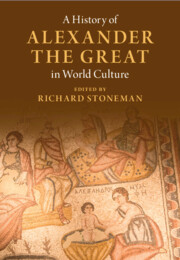Book contents
- A History of Alexander the Great in World Culture
- A History of Alexander the Great in World Culture
- Copyright page
- Contents
- Figures
- Notes on Contributors
- Preface
- Abbreviations
- 1 Introduction
- 2 Alexander and Alexandria in Life and Legend
- 3 The Image of Alexander in Ancient Art
- 4 Alexander, Philosophy and Rome
- 5 Christianising Alexander Traditions in Late Antiquity
- 6 Alexander in Ancient Jewish Literature
- 7 The Medieval Alexander
- 8 Alexander the Great and the Crusades
- 9 The Slavic Alexander
- 10 Alexander the Great in Byzantine Tradition, AD 330–1453
- 11 The Spanish Alexander
- 12 The Persian Alexander (1)
- 13 The Persian Alexander (2)
- 14 Alexander in Medieval Arab Minds
- 15 Alexander in the Age of Shakespeare
- 16 Alexander the Great in Opera
- 17 Alexander in the Long Eighteenth Century (c.1660–1830)
- 18 Images of Alexander in Germany
- 19 Alexander the Gay and the Gloryhole That Was Greece
- Index
- References
16 - Alexander the Great in Opera
Published online by Cambridge University Press: 13 January 2022
- A History of Alexander the Great in World Culture
- A History of Alexander the Great in World Culture
- Copyright page
- Contents
- Figures
- Notes on Contributors
- Preface
- Abbreviations
- 1 Introduction
- 2 Alexander and Alexandria in Life and Legend
- 3 The Image of Alexander in Ancient Art
- 4 Alexander, Philosophy and Rome
- 5 Christianising Alexander Traditions in Late Antiquity
- 6 Alexander in Ancient Jewish Literature
- 7 The Medieval Alexander
- 8 Alexander the Great and the Crusades
- 9 The Slavic Alexander
- 10 Alexander the Great in Byzantine Tradition, AD 330–1453
- 11 The Spanish Alexander
- 12 The Persian Alexander (1)
- 13 The Persian Alexander (2)
- 14 Alexander in Medieval Arab Minds
- 15 Alexander in the Age of Shakespeare
- 16 Alexander the Great in Opera
- 17 Alexander in the Long Eighteenth Century (c.1660–1830)
- 18 Images of Alexander in Germany
- 19 Alexander the Gay and the Gloryhole That Was Greece
- Index
- References
Summary
Librettists and composers began to create operas based on Greco-Roman myths in 1598, but operas based on ancient history did not appear until 1643, and Alexander operas not until 1651, when Sbarra’s Alessandro vincitor di se stesso and Cicognini’s Gli amori di Alessandro Magno, e di Rossane were produced. Source materials are problematic for identifying every received title accurately, but clearly the corpus of Alexander operas is large. Pagan divinities appeared in the earliest Alexander operas, particularly in prologues, but this was operatic convention, not because of Alexander’s divinity. Thereafter, Venetian operatic plot formulas often shaped Alexander’s characterisation, as did aristocratic patronage. But because the Alexander historians described so many types of episodes displaying a range of characterisations from magnanimous to vindictive, roles for the operatic Alexander varied widely, as did texts for individual productions. Metastasio’s Alessandro nell’Indie was the most frequently produced Alexander opera, enduring for nearly a century. But after the Napoleonic era production dwindled considerably.
Keywords
- Type
- Chapter
- Information
- A History of Alexander the Great in World Culture , pp. 350 - 374Publisher: Cambridge University PressPrint publication year: 2022

